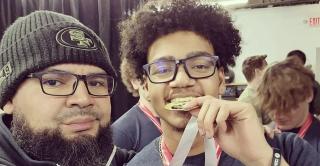
Overview
At Central we value personal integrity as fundamental to our interactions with each other. We believe that one of the purposes of Central is for students learn to think critically, to develop evaluative skills, and to express their own opinions and voices. We place special weight on academic honesty in all of our intellectual pursuits because it is a value that is fundamental to academic life and scholarly practice. All members of the Central are obligated to uphold high standards of academic honesty in their scholarship and learning. Therefore, we expect students to take personal responsibility for their intellectual work and to respect and acknowledge the ideas of others. Academic honesty means doing one's own work and giving proper credit to the work and ideas of others. It is the responsibility of each student to become familiar with what constitutes academic dishonesty and plagiarism and to avoid all forms of cheating and plagiarism.
What is Academic Misconduct?
Academic misconduct includes providing or receiving assistance from sources such as other individuals, websites, mobile devices, applications, and artificial intelligence without prior instructor authorization, in the creation of work to be submitted for academic evaluation (including papers, projects and examinations).
Plagiarism is one form of academic misconduct and defined as presenting, as one’s own, the ideas or words of another source, as noted in the previous paragraph, for academic evaluation, without proper acknowledgment. Plagiarism includes, but is not limited to: (i) copying sentences, phrases, paragraphs, tables, figures, or data directly or in slightly modified form from a book, article, or other sources as noted in the previous paragraph without using quotation marks or giving proper acknowledgment (e.g., citation) to the original author or source; (ii) copying information and submitting it as one’s own work; (iii) buying papers for the purpose of turning them in as one’s own work; and (iv) selling or lending papers to another person for submission by that other person, for academic evaluation, as his or her own work. Much of this information is taken directly from the Student Code of Conduct and Statement of Judicial Procedures.
Examples of Academic Misconduct
Exams:
- Copying from another person’s paper or receiving unauthorized aid from another source during an examination;
- Utilizing artificial intelligence (AI) tools (e.g. ChatGPT, PhotoMath) during an exam to answer questions (multiple choice or short / long response questions)
- Use of unauthorized materials or devices during an examination or any other form of academic evaluation and grading; e.g., use of signals, notes, books, or calculators during an examination when the instructor has not approved their use;
- Knowingly allowing another person to copy from one’s paper during an examination;
Improper Behavior:
- Use of another person or source as a substitute in any form of academic evaluation or acting as a substitute for another person in any form of academic evaluation, e.g., a student cannot have another person take an examination for him/her.
- Acquisition or distribution of improperly acquired examinations; e.g., stealing examinations before the test period or taking a copy of an examination from a testing room without the permission of the instructor; (Examinations which have been distributed by an instructor are legitimate study tools);
- Submission of material from another person or source as one’s own for academic evaluation
- Preparation of work for another student to submit for academic evaluation;
- Unauthorized collaboration in the preparation of materials to be submitted for academic evaluation; e.g., working with another student on an assignment when the instructor has not authorized working together;
- Submission of output generated by AI tools as one’s own for academic evaluation
- Utilizing AI tools to complete assignments when the instructor has not authorized such usage.
- Submission of the same work, or substantially similar work, in more than one course without prior consent of the evaluating instructor(s);
- Disruption in classroom, lab, or research and study areas; any conduct or actions that grossly or persistently interferes with the academic process. (See the CSU, Rights and Responsibilities, "Proscribed Conduct," No. 7, Central Student Handbook.)
Falsification or Misuse of Academic Information:
- Falsification or misrepresentation of one’s own academic record or that of anyone else; e.g., altering a transcript for admission, hacking into Central's computer system and changing a grade, having another student take an examination in one’s place, signing someone else's name to an attendance sheet.
- Unauthorized use of information in Central computer records or the computer files of other students (see Computer Use Policy);
- Using unauthorized materials or fabricated data in an academic exercise; e.g., falsifying data in a research paper or laboratory activity; conducting research on human or animal subjects without review by the appropriate panel or supervisor.
Plagiarism:
- Copying sentences, phrases, paragraphs, tables, figures or data directly or in slightly modified form from a book, article, or other academic source without using quotation marks or giving proper acknowledgment to the original author or source.
- Copying information from other sources (including AI tools) and submitting it as one's own work;
- Utilizing AI generated texts without citation
- Buying papers for the purpose of turning them in as one's own work;
- Selling or lending of papers for the purpose of violating academic honesty policies (this may also be an academic crime, see Connecticut General Statutes, §53-392a.)
How to Avoid Plagiarism
In practice, plagiarism is regarded as theft, intended to gain undeserved credit. Like other forms of academic dishonesty, plagiarism is cheating. To academicians, a well-documented paper is more impressive than one which arouses the suspicion of a reader familiar with the student's work and alert to echoes from other writers. The proper use of outside sources does not necessarily mean that a paper is lacking in originality, nor does the presence of quotation marks in the text. In fact, the purpose of research and documentation is to share useful information with the reader. The penalties for plagiarism greatly exceed the unlikely reward of gaining credit by getting away with it. Students must be careful to avoid plagiarism and are responsible for learning how to present the ideas of others in their own work. For current documentation practice, consult the instructor and a style manual. When material is borrowed from another source of any type, the source must be indicated. There are three ways in which another writer's material may appear:
By putting quotation marks around short passages borrowed verbatim (word for word); or by setting off from the text, without quotation marks, for longer quotations.
By precis; condensing part of a writer's argument.
By paraphrase: interpretation of a writer's ideas.
All three must be acknowledged either in footnotes or informally in the text.
How to cite the output of a program that utilizes artificial intelligence (such as a chatbot like ChatGPT):
MLA https://style.mla.org/citing-artificial-intelligence
Cite the platform on which you interacted with the program and the author of the program if you find one listed.
Author last name, Author first name. “Name of chat.” Name of AI, URL.
(example from their webpage)
For example, if you are describing your chat with a version of Eliza, a program developed in the 1960s that mimics a psychotherapist, you might cite it as follows:
Eliza‘s responses have some limitations. In response to the question “What is your name?” it answers, “Have you asked anyone else?” (Dunlop).
Work Cited
Dunlop, George. “Eliza, Computer Therapist.” Manifestation, www.manifestation.com/neurotoys/eliza.php3.
APA According to an email exchange between Joy Hansen, Central and Stefanie Lazer, APA Style Expert at styleexpert@apa.org (2/9/2023):
The APA Style team is currently collecting feedback so that they can construct official guidelines. What follows is interim guidance and should not be considered the final word.
Because the purpose of references is to direct readers to the specific sources that a writer used, hopefully the text that ChatGPT generates in any particular chat can be saved, is shareable, or is otherwise retrievable. If so, the reference format in Section 10.10 (Software) can be used, with the company (“OpenAI”) as author, not “ChatGPT.” If the chat has no title, a description in square brackets (that ideally includes information on what prompts were used) would be created. That would give us the following:
OpenAI. (2023, January 17). [ChatGPT response to a prompt about three prominent themes in Emily Dickinson’s poetry]. https://chat.openai.com/.....
If the text that ChatGPT generates is not retrievable or sharable, then it falls into [the] catch-all “personal communication” category, where you cite with an in-text only citation: “(OpenAI, personal communication, January 16, 2023).” However, this is not an entirely satisfactory option, especially because the technology is so new, so both students and instructors are learning about this resource and how to ethically use it. Consider, then, making the ChatGPT conversation retrievable by including the text as an appendix or as online supplemental material. If you do so, then readers may be referred to the appendix or the online supplemental material (where the ChatGPT response may be contextualized) when the ChatGPT conversation is cited. It would be good practice to describe, in the narrative or a note, the prompt that generated the specific ChatGPT response. This too will help inform the understanding of the technology and its outputs.
Resources to avoid plagiarism:
Burritt Library Research Guide on Citing Sources
Blackboard SafeAssign Software
Central Learning Center Academic Integrity Workshops
Click here for a printable copy.
[1]The following material is adopted from the original Policy on Academic Misconduct that was approved by the Faculty Senate on 11/05/01, which is superseded by the Disciplinary Procedures for Academic Misconduct approved by the Faculty Senate on 5/10/10 and amended on 2/14/11. This material is provided as a resource for understanding and preventing academic misconduct.


